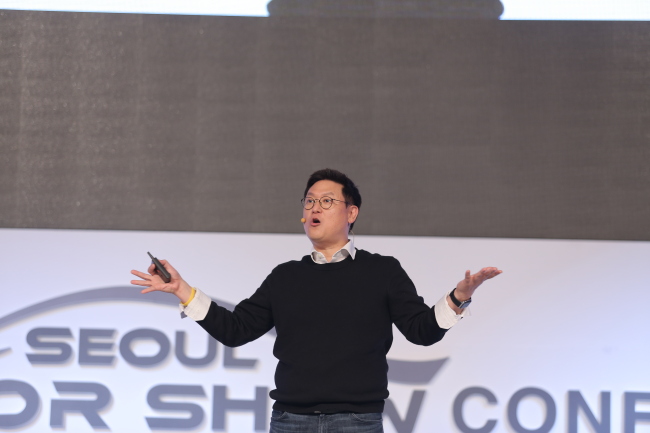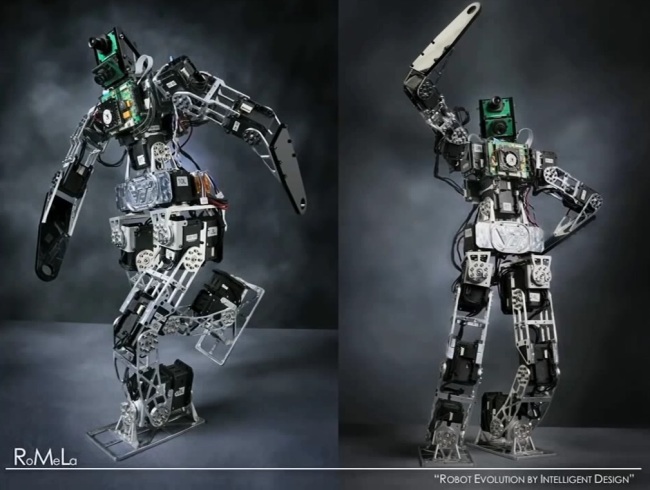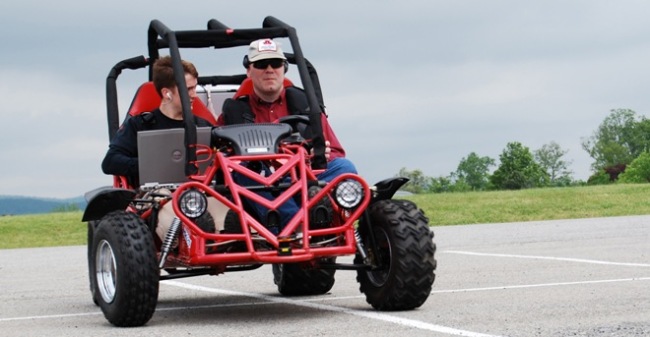At the age of 7, Dennis Hong went to the movie theater with his parents as one of the many millions itching to watch the first Star Wars film on the big screen.
However, this simple family night outing ended up forever changing the course of his life.
“Seeing R2-D2 and C-3PO fascinated me. On my way back home in the car, I told my mom and dad that I am going to be a robot scientist … and since then, I never changed my mind and I am still following my dream to this day,” Hong told The Korea Herald last week.
The Korean-American robotics expert was in Korea to speak about his research at this year’s 2017 Seoul Motor Show.
 |
Dennis Hong, professor at the University of California, Los Angeles and founder of RoMeLa (Robotics and Mechanisms Laboratory). (Seoul Motor Show) |
Now at the age of 46, Hong is a professor at the University of California, Los Angeles and founder of RoMeLa (Robotics and Mechanisms Laboratory). He was honored at Popular Science’s 8th annual “Brilliant 10” ceremony that awards the best American scientists under 40 and has won the National Science Foundation’s prestigious Career award for his work in robotics and mechanical engineering.
Among his many international accolades, the roboticist is also the creator of CHARLI (Cognitive Humanoid Autonomous Robot with Learning Intelligence), the first full-size, two-legged, walking humanoid robot to ever be built in the States.
However, Hong says the purpose of his research is not simply to create and build cool gadgets. Rather, he is in pursuit of developing technologies that can further advance and better people by helping to eliminate “3-D” -- dull, dirty and dangerous -- jobs that he feels people should not, or cannot do.
“A lot of times when people ask me what a robot means to me, they expect me to say something like, ‘My robots are my companion, they’re my friends,’ but no. What I say is, ‘A robot is a tool,’” he said.
“In my case, I develop technology to help people, to give them freedom, to give them independence, to give people happiness. ... That is what drives me and I believe it is the key to change the world.”
Hong is one of the minds behind innovative robot creations such as the SAFFiR, an autonomous bipedal robot designed to locate and extinguish fires on naval ships.
While some of the public criticize the vast development and advancement of new technology such as robots as a threat to society and the human workforce, Hong urges people not to base their opinions based on ideas and ideologies being popularized in science fiction movies.
“It is true that robots will be replacing human jobs. ... But if you think about it, it’s really nothing new,” he explains. “It’s just a shift. Before the automobile, there were no gas stations, there were no auto mechanics, there were no car dealers, no car insurance. But these are just some of the new types of jobs that were created because of new technology.”
However, despite having developed some of America’s most state-of-the-art robotic mechanisms, Hong says one of his biggest struggles is trying appease the public’s high standards, which are solely mitigated based on the futuristic technology that everyone sees on TV.
“Some people’s expectations are so high,” Hong says. “Let’s take humanoid robots. Our robots are cutting-edge, state-of-the-art robots. Kids come to our labs, see our robots walking and they are like, ‘Wow!’ But after about 30 seconds, they say, ‘Why can’t it run? Why can’t it do this?’”
Even after explaining that sort of advanced technology does not yet exist, people always seem so perplexed, he says, claiming that too much of the public’s perceptions of robots and highly-advanced technology stems from science fiction.
This same type of false perception can also be applied to the public’s understanding of autonomous cars, he added.
Before he began focusing on humanoid robots, Hong’s first passion was automotive technology.
 |
A photo of one of Dennis Hong’s humanoid robot prototypes. (RoMeLa) |
In 2007, Hong and his team decided to tackle the Defense Advanced Research Projects Agency (DARPA) Urban Challenge. As an agency of the US Department of Defense, the DARPA program creates certain challenges in order to encourage the development of technological and scientific breakthroughs.
For the Urban Challenge, teams had to build an autonomous car and drive through an urban environment all on its own, obeying all the rules of the road.
“Back in 2007, autonomous cars or driverless cars were the stuff of science fiction,” he said.
Hong and his team won third place, creating a vehicle that was able to drive on its own for 6 to 7 hours, and received $500,000.
Shortly after, Hong realized self-driving technology had become the new flavor of the month. Not wanting to follow a popular trend, as soon as autonomous driving technology started garnering mainstream interest he said he searched for the next innovative idea that could keep his creative juices flowing.
And where did that lead him? Hong went onto to create the world’s first car that can be driven by the blind.
“This is important, it is not an autonomous car you put a blind person in, it’s a car where a blind person can make active decisions and actually drive the car,” he explained. “This wasn’t really a research project about cars, it wasn’t about driving, what it was really about was user interfaces -- how a machine or a computer can communicate with a person.”
 |
A view of RoMeLa’s go-kart test drive using its driving for the visually impaired technology. (RoMeLa) |
“The question was, how can you have a computer communicate to a human without vision?” he asks.
“So we developed all types of non-visual interfaces -- gloves that vibrate certain patterns, a seat that vibrates, even a computer screen that we call ‘airpix,’” Hong continued. “It’s a tablet with thousands of holes that shoots out compressed air that can draw images (allowing drivers to understand an upcoming road situation by the feel of the air on the hand).”
To this day, autonomous technology is still considered to be the next big thing in the automotive industry, with global automakers still trying to develop self-driving technology that will be ready for mass consumer production.
According to many leading automotive industry officials, the public can expect to see fewer manually driven cars on the road in as little as three years from now. Worldwide sales of self-driving cars are forecast to reach annual sales of 20 million units by the year 2035, according to a report by the Korea Institute for Industrial Economics and Trade.
With the continued expansion of the smart car market, the report projects self-driving cars will start hitting the roads around 2020.
However, Hong says the type of self-driving vehicles seen in futuristic movies is not a technology to be expected anytime soon.
“The truest sense of autonomy, like in the ‘The Jetsons,’ (an American cartoon show about futuristic family) where you get in the car and just take a nap, wake up and you’re there; that is not going to happen anytime soon,” he said, although he said the technology would undoubtedly exist sometime in the distant future.
“Yes we’ve seen Google and Uber’s self-driving cars, and I think this gives people a sense of false hope that these cars will be made available soon. But I don’t think that is true,” adding that many vehicle’s that claim to be fully autonomous, are still only semi-autonomous.
What is in store as far as the near future is concerned, according Hong, is that fully autonomous vehicles will most likely only be available for use in certain cases, such as on special highway lanes and certain city sections.
“There’s a true driving force behind this (autonomous vehicles) … I truly believe it’s going to happen just because we have so much money at stake. However, the key is this. In technology, the first 98 percent to make a truly working, consumer ready vehicle robot, is not the difficult part. It’s the last 2 percent.”
“When you develop prototypes, it’s okay if it fails one or two times, it’s in a controlled environment. But if you want to have a vehicle for people to really use, achieving that high reliability is so difficult,” says Hong.
“The real message is this. Many times researchers, or even the general public, we are obsessed with new, cool cars and new technology -- autonomy, interconnectivity, electrification -- all these buzz key words,” Hong says. “But many times because of these buzz words, we often lose what the true meaning, the true nature of what an automobile is. A car is not just a device that makes you move from point A to point B, it’s much more than that. It’s a culture.”
By Julie Jackson (
juliejackson@heraldcorp.com)










